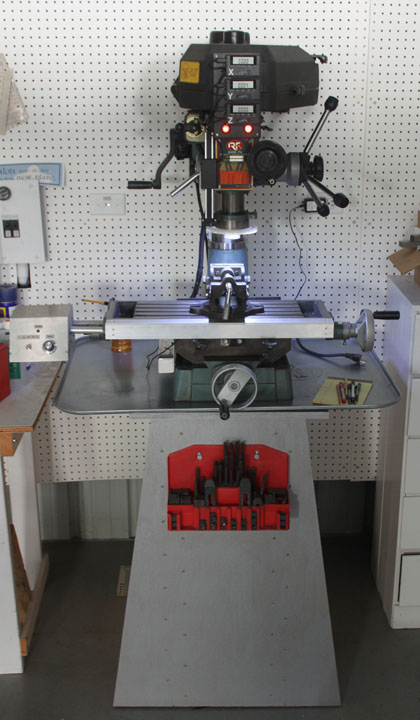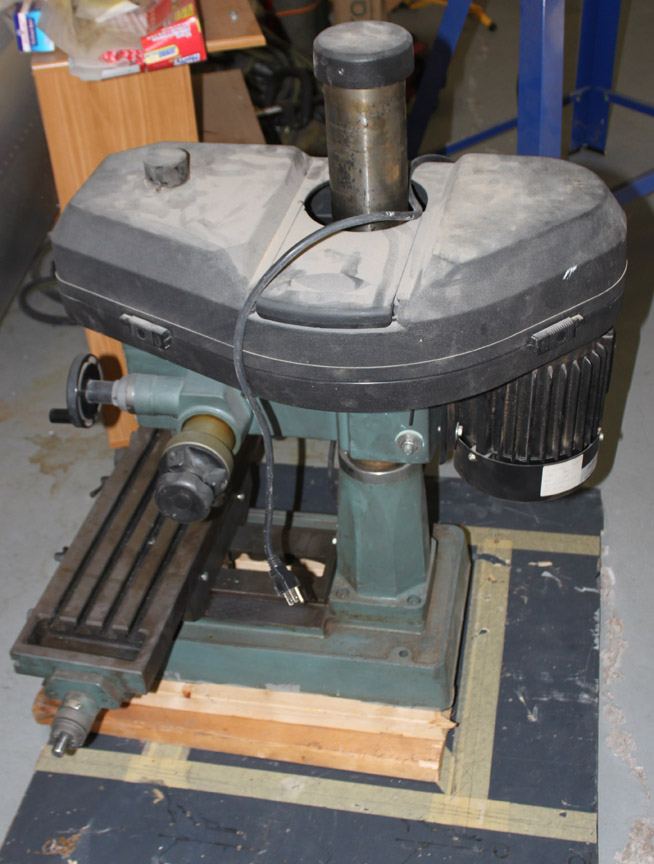
Fig. 1
Above is a current picture of my milling machine - this
web site is a log about how that came about. The menu on the left has
links to pages about making the stand, light, power feed, and other
modifications or enhancements I've made for this machine. There is also
one on a bandsaw I "rescued" to cut the metal down to size to
be milled.
(Note about using this website - if you want to see any
of the photos on this website in a larger format, you can. If you are
using Firefox or Internet Explorer, right-click on the photo and select
"view image..." If you are using Chrome, right-click on it and "open
image in new tab...")
So, to begin at the beginning:

Fig. 2
October, 2011: I bought a
used (new to me) Rong Fu Mill/Drill from a friend. Above is a picture
of it after I wrestled it to a workshop space using my pickup and an
engine hoist. Although it is 12 years old at this time, it has only
seen some light use, but still had some of the original packing grease
(cosmolene?) on it as well as dirt and some light rust.
It's official name and specs are: Rong Fu Model No.
MMD-91000D Vertical Milling Machine, Serial No. 932042, 7" x 20"
T-Slotted Table, 10" Longitudinal Travel, 4" Cross Table Travel, 4"
Quill Travel, 12 Spindle Speeds: 110 - 2580 RPM, R-8 Spindle Taper, 1
HP, 120 V, Single Phase Motor, Approximately 38" x 38" x 38" built in
1999. It weighs about 600 pounds and its base foot print is 12 x 20
inches.
I believe it is an early model of the very popular RF-15/RF-20/RF-30 series of round column mills produced by Rong Fu who created different model numbers based on variations on a basic theme - variations consisted of different powered motors, different table dimensions, number of speeds (pulleys), which all affected the overall weight of the mill. All of them utilized the same basic base, column, and quill. Another variation was placing the depth stop/indicator from a left mounted threaded rod with stop nuts to one centered on the face of the upper mill, as well as having a reverse switch on the motor. These mills were not only sold under a bunch of different brand names besides the Rong Fu name, but were cloned by some Chinese companies. There is some opinion that the Taiwan (Rong Fu) versions are of a higher quality than the Chinese ones, but I gather that this is somewhat subjective.
This particular model is on the low end, having a small motor, and only providing 10 x 4 x 4 inches of travel. Nevertheless, it seems very stable and solid, and I should be able to make a lot of parts with it.
This model is a round column base mill, which has the consequence that you can't raise the head (independent of the quill travel) without upsetting the X-Y zero point. Although some forethought about the order of operation can often eliminate the need to do this, some technique will need to be figured out to compensate for this. Also, much has been written about the accuracy and backlash of using the table handwheel indicators, so something like DROs will transform its utility.
Above is the product plate, and on the right is the type
of forward/reverse switch supplied with the motor. One of the first
things I needed to do is clean it up and get some rust proofing on it
before the winter sets in and it gets to be too cold work in the
unheated workshop. This will involve taking it apart, cleaning
everything, treating everything with a proper lubrication, and rust
proofing the rest. I need to do something about a stand for
it, of course, and I am thinking of putting some kind of
accurate but low cost DRO (Digital Read Out) capability on it.
Modifications for the mill are on separate pages and
listed in the menu at the top of this page on the left.
Comments may be addressed to gary
at liming daught org.
Visitor Map